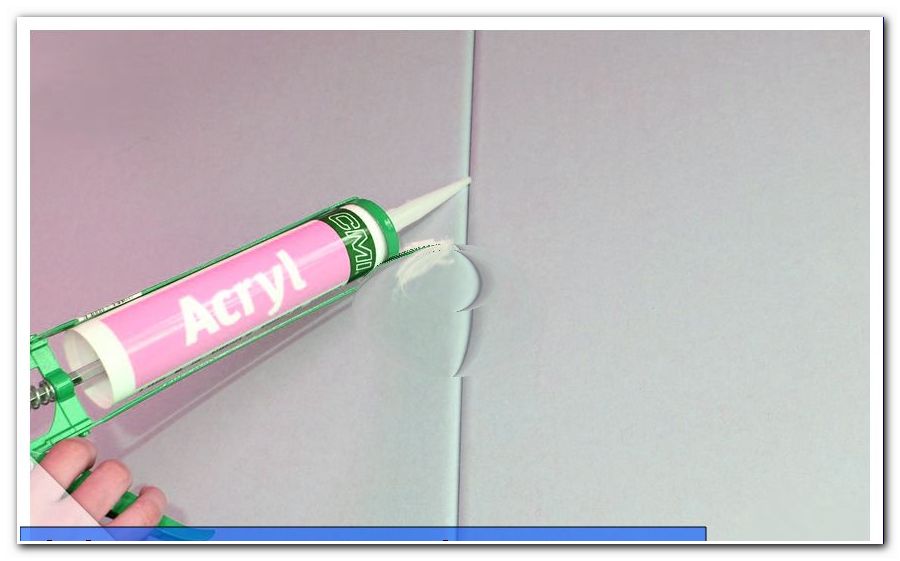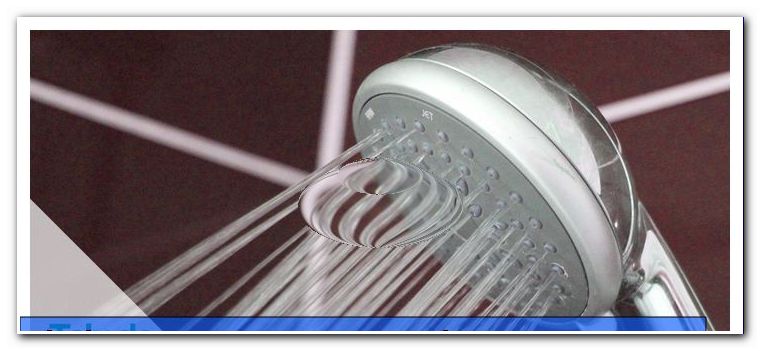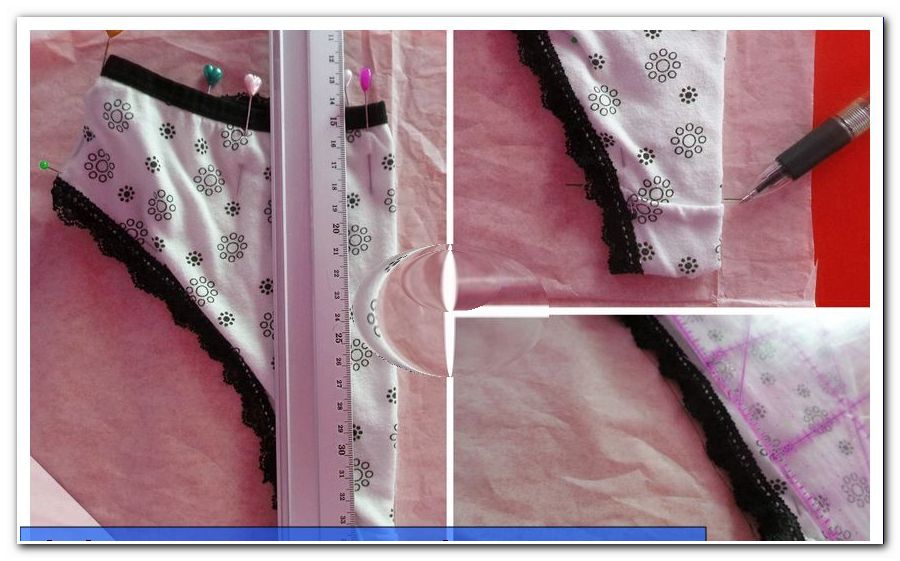Acrylic or silicone? When it is used where - differences

- Acrylic or silicone - the difference
- Silicone application
- Advantages and disadvantages
- Acrylic application
- Advantages and disadvantages
- Process silicone and acrylic
- Conclusion
Acrylic and silicone are various sealants that are widely used in professional crafting and home improvement. Both sealants are very similar in their appearance and consistency. But the sealants show clear differences that every handyman or do-it-yourselfer should know. The use of the respective sealant depends on its intended use.
Various areas of application for sealing compounds are often present on the construction site, in the house or in the apartment. Joints in the bathroom or in the kitchen should be sealed, cracks sealed in the masonry or joints of window sills, baseboards, shutters, worktops and others grouted. Appearance, nature and processing of the two sealants hardly differ from each other. Both sealants have a paste-like consistency. After curing, the acrylic and silicone change to a rubbery state. Skilled craftspeople can recognize acrylic and silicone in the appearance by means of small details, but for laymen it is hardly possible to distinguish them at first glance.
Acrylic or silicone - the difference
Despite the seemingly similarities in the rubber-like appearance and the paste-like consistency of the mass, acrylic and silicone can be distinguished in the dried state on closer inspection. The hardened acrylic mass feels harder than silicone. The silicone has a glossier surface than acrylic. The acrylic looks dull and dull. Experienced craftsmen and do-it-yourselfers can, thanks to their many years of experience with the sealants, recognize the slight deviations of the substances even when wet.
A little tip to distinguish between silicone and acrylic in the wet state
One way to distinguish the two sealants in the wet state is the "Fingerprobe". A small amount of the sealant is rubbed between two fingers. Silicone then has an oily-greasy texture. The hand must be cleaned with a damp washcloth from the silicone residues. For this reason, when working with silicone always have a wet cloth to clean your hands. When rubbing acrylic between the fingers, the firmer state of the mass is felt. The rubbery acrylic curls up into small solid balls or other shapes. There are hardly any residues left on the fingers.
Distinguishing feature in the cured state
In the cured state, the two sealants can be distinguished very well when removing. Silicone then has a very elastic consistency, while the acrylic is much harder. But even in still grouted condition silicone and acrylic can be well distinguished after a long curing time. Acrylic joints may have assumed a much drier and cracked appearance. The color of acrylic joints can show significant changes. The elasticity of silicone, however, is long-lasting. Over time, the joints, for example in the bathroom or in the kitchen, may have changed slightly in color on the surface. When thoroughly wiping with a damp cloth and non-abrasive cleaning agents, however, the bright original color can often be made visible again after a short time. Even old joints can appear in a light white or their other original color after a thorough cleaning.
Differences between acrylic and silicone in a quick overview
| Properties of acrylic: | Properties of silicone: |
|
|
Silicone application
The most common uses of silicone sealant
Due to its water impermeability and water-repellent behavior, silicone is preferably used in sanitary areas, for example for sealing bathtubs, showers or wash basins as well as in other places and often also for sealing worktops in kitchens. Its fungicidal action, which means defending against mold growth, continues to be an outstanding feature of the silicone sealant for use in toilets, bathrooms and kitchens.

Due to the elastic behavior of silicone, the sealant is also preferred for grouting tiles in sanitary areas, in the kitchen or in expansion joints. It can be used equally for wall and floor tiles and adheres well to smooth surfaces. Furthermore, the high elasticity of the material also offers particularly good applications in all areas with moving surfaces. The sealant can have a balancing effect on, perhaps over time changing and working surfaces, such as in many timber structures or the like. Some retailers now also offer silicone sealants that can be used outdoors, for example in the garden, on the balcony or on the terrace.
These silicone compositions also have a resistance to heat or cold to their water-repellent properties. They are therefore very resistant to weathering. Another advantage for many applications is the insulating properties of the silicone compared to electricity. In order to choose the right silicone compound from the large range for the respective area of application, the respective details of the manufacturer should be read and checked carefully.
Little tip for the use of silicone:
Since silicone is available in different colors, it can also be used very well for design elements in the wall and floor tile area.
Advantages and disadvantages
An advantage of silicone is that the sealant does not lose volume over time. The elasticity of silicone is maintained in the long term. This means that even after a long time in the joints no leaks caused by delamination or cracks, through which moisture could penetrate into the masonry or other areas to be protected. As a disadvantage in some applications, it could be shown that the silicone composition can not be painted over. The processing in several layers is not possible.
The biggest advantage of silicone over acrylic is the impermeability to water. For some silicone compounds, which are mainly intended for the sanitary sector, a slightly sweet, vinegar-like odor may occur during the curing process due to an acetate release to the ambient air. In the trade, however, low-odor silicone sealants can be obtained.
Acrylic application
The most common applications of acrylic sealant
Acrylic is used as a sealant for sealing and repairing cracks in masonry. Acrylic is also used in the entire interior design, the dry areas in the house or in the apartment, for example as connecting joints on doors and windows. The acrylic sealant is a coarsely porous mass and loses its elasticity in the curing process. It has no fungicidal effect on molds. For this reason, the acrylic should not be used in the sanitary area or in other places where the sealant could have water contact. Mold formation can occur in sanitary or damp rooms not only through direct contact with water, but also through water vapor and high humidity.

Advantages and disadvantages
Due to its low elasticity, acrylic can hardly be used in expansion joints, on moving or working surfaces. Minor strains or variations in joints can be compensated by the acrylic sealant. An advantage, however, is its good adhesion to various substrates, such as masonry, plaster, wood, plaster and glass. Since acrylic can be painted over and, in many cases, should also be painted over to protect against the ingress of moisture, it is ideal for various repairs to walls and masonry. The cracks or damage, for example, on walls can be repaired with acrylic so that the damaged areas are invisible.
Process silicone and acrylic
Silicone or acrylic sealants are most commonly sold commercially in cartridges used in hand-held guns. Larger quantities in buckets are available. Other forms of packaging are tubular bags or small tubes for minor repair work. In addition to the manual guns, the sealants can also be processed by means of battery spray guns or air pressure guns.

After application of the compounds in the joints, both sealants should be smoothed with a spatula or with a finger for a uniform result and to complete the interstices. Smooth drawing prevents the formation of air holes or cracks. When smoothing acrylic with a finger, some water should be provided to wet the finger skin. So no particles of the acrylic sealant can get stuck on the moistened skin. For smoothing silicone joints, a release agent must also be used for smoothing. With the help of this release agent, the silicone can not get caught on the fingers. The silicone sealant remains in the joint and is not unintentionally pulled out of the gaps during reworking.
Use the appropriate silicone or acrylic sealant
For work on masonry or plaster, commercially available coarse-grained, plaster-like acrylic compounds are available. In this way, the repairs can be optimally optically adapted to the environment. For sealing or jointing at glass connection points, transparent sealing compounds made of silicone or acrylic are also commercially available. When buying acrylic or silicone sealants, attention should be paid to the manufacturer's instructions and the respective purposes. There may be differences in individual acrylic or silicone compositions, such as painter acrylic, plaster acrylic, Bäders silicone with increased fungicidal action and the like.
Conclusion
Silicone and acrylic are sealants with a wide range of applications. They are suitable for grouting wall and floor tiles, for grouting expansion joints, for sealing on smooth or even uneven surfaces, for joining and grouting different materials, such as wood, ceramics, plastics, glass, stone and more. Important when working with the sealing compounds, which appear very similar at first glance, are the knowledge about the considerable differences and their use in different fields of application.
Silicone, for example, finds a particularly preferred use in sanitary or humid areas, such as in the bathroom, toilet or kitchen, due to its water-repellent and highly elastic properties. Its fungicidal action also makes this material ideal for use in humid environments. The formation of mold in the joints or seals can be effectively prevented.
Acrylic sealant is suitable for use in dry areas. It is used in interior design and for repairing damaged areas, cracks on walls and masonry. An advantage is its good adhesion to various substrates, such as stone, masonry, plaster, wood, glass, plasterboard and other building materials. Acrylic can be painted over and can thereby "invisibly" adapt to its surroundings. The processing method is similar and simple for both sealants, acrylic or silicone, for example with pressure cartridges or pressure guns.




